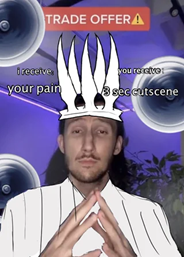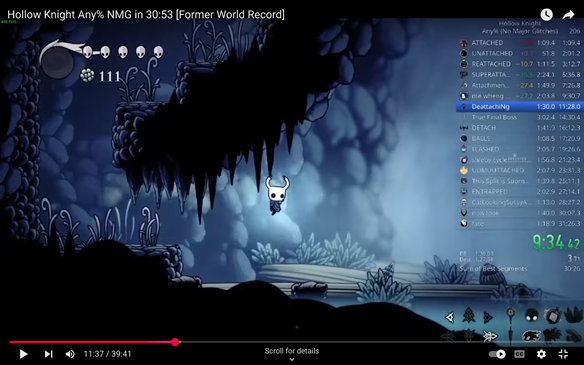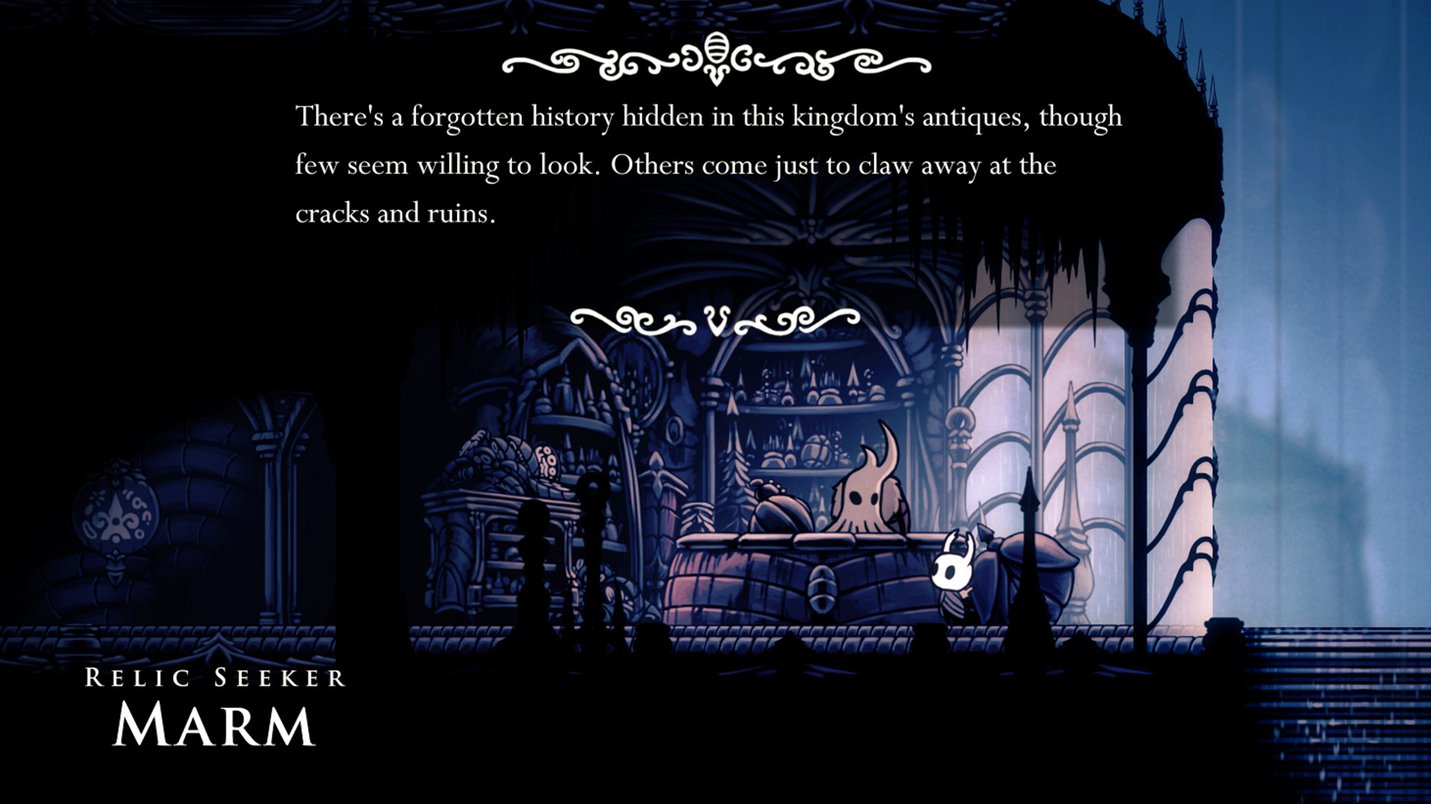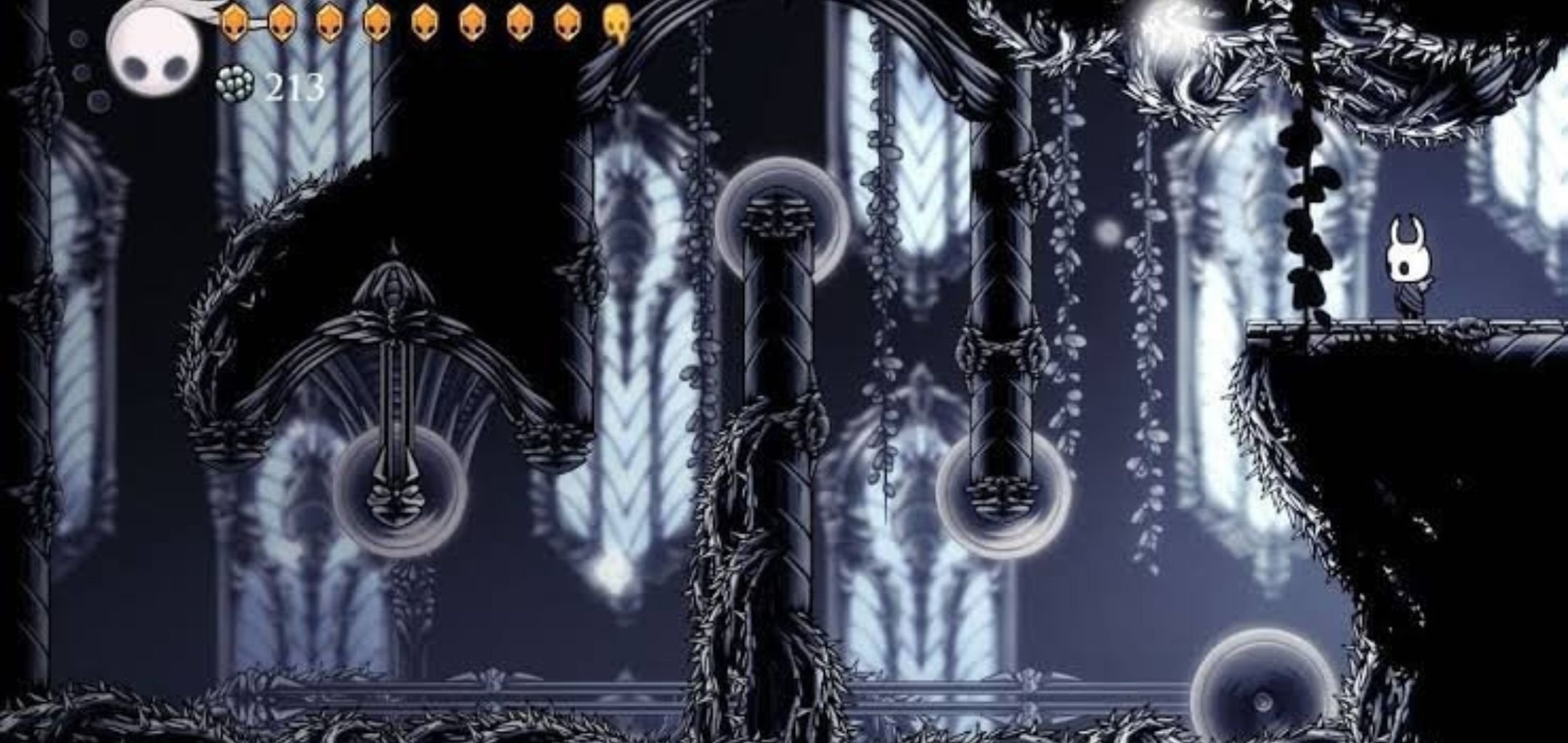From the first few moments of Hollow Knight, the game signals that it might be a tough one.
The Knight tumbles into a dark cavern, water dripping from the ceiling. Sharp spikes fill pits between narrow platforms, while stalactites crash down from above, threatening the few precious lives of our small but mighty hero. Hollow Knight forgoes a tutorial and a quest log. There’s no mission marker, and no autosave; an hour of progress may be lost in one misstep. Yes, Hollow Knight is hard. But difficulty isn’t just an obstacle for players to overcome; it’s a vital conduit for fan knowledge. This shared knowledge causes laughter, hones skills, shapes experts, forges communities, and even creates resistance against corporate control of digital spaces.
It’s no wonder that so many memes produced by fans reference how hard the game is. The “Path of Pain” is an infamous optional area in Hollow Knight that promises a secret at its end. To get to it, players must dodge thorny vines, flying buzz saws, metallic spikes and even survive a surprise attack from two White Palace guards – almost completely without touching the ground. The Path of Pain takes some notes from ‘masocore’ (masochism + hardcore), a term popularised by game designer Anna Anthropy.[i] Masocore games have levels “designed specifically to frustrate the player and require trial and error to conquer – as well as extreme skill”,[ii] and as Anthropy points out, they upturn player expectations – like a joke.

In a video essay on Elden Ring[iii] – a game notorious for its difficulty – Jenna Stoeber likewise suggests that difficulty can be an excellent source of humour. Hollow Knight players share memes about the absurd number of saws in the White Palace, or the ridiculously short cutscene they’re rewarded with for surviving the Path of Pain. A quick YouTube search reveals countless expletive-filled videos of players failing the Path of Pain over and over again. There’s a schadenfreude derived from watching these fumbles, but the humour is also self-deprecating; creators lean into the pain, with video titles calling themselves noobs or thumbnails showing them clutching their heads. But watching these also dulls the sting of failure, knowing that others have been through it, too, and when defeating a difficult boss can’t be achieved, sharing laughter with other players can be a sweet release similar to the one gained when a boss is finally beaten. As Stoeber explains: “Laughter is also a necessary form of social connection. It can help you find like-minded people … you learn from them and laugh and feel connected to other people being jerked around by the game”. And we do learn from the shared masochism of these memes and ‘Lets Play’ clips. Through them, fans cultivate a light-hearted attitude towards failure that demonstrates a model of play that says: dust yourself off, laugh about it, and try again.


While Hollow Knight memes allow fans to laugh at their collective pain, fans of the game also produce what media theorist Henry Jenkins – using Pierre Levy’s term – would call a “collective intelligence”, to describe the pooling of individual knowledge, skills and resources into a shared cultural knowledge.[iv] In the Hollow Knight fandom, collective intelligence is typified in the work that speedrunning, fan artists, fan theorists, and wiki communities do in the making, exchanging and refining of knowledge.
In trying to scale ledges, avoid Primal Aspids, and traverse Hallownest as quickly as possible, Hollow Knight speedrunners need incredible hand-eye coordination, accuracy and reflexes. YouTuber and Hollow Knight speedrunner BlueSR charts the history of the ‘Any% No Major Glitches (NMG)’ speedrunning category[v], showing the progress of runners since the run began in the days after the release of Hollow Knight. 'Any%' refers to reaching the end of the game as quickly as possible by any means possible, while ‘NMG’ disallows the use of glitches that too drastically change the intended path of the game. Players must use all their skills to deal with the game’s mechanical difficulty, a term that media theorist Patrick Jagoda employs to describe difficulty that requires ‘familiarity with the designed system and a cultivation of physical or strategic skills that enable success or mastery.’[vi]
Jagoda brings more nuance to the definition of difficulty by introducing interpretive difficulty: the skills players use in reading and understanding a game. This isn’t limited to interpreting a narrative: it also includes decoding game elements, parsing the spatial make up of the game (can I make that jump if I shoot soul in the opposite direction, pushing me towards the platform?), calculating which routes are fastest, and exploiting glitches to achieve a faster time.
Rather than celebrating the accomplishments of any one player, these speedrun videos chart a collective achievement towards a lower time. Speedruns must be recorded and uploaded to be validated, resulting in runner’s improvements becoming improvements other speedrunners can learn from. “Glitch hunters” search for bugs that can be exploited to assist with speedrunning, sharing their discoveries in dedicated Discord groups or forums for others to use. Some discoveries create breakthroughs, like “wallcling storage”, which BlueSR credits speedrunner Scruffy for finding. By tricking the game into thinking the player is grabbing onto a wall when they’re not, speedrunners can maintain dash momentum, allowing them to zip like lightning across large areas.
Other discoveries are made by players doing Tool-Assisted Speedruns (TAS). These are, theoretically, perfect runs, made using emulators. Players slow down the rate of play, pausing and reloading in order to achieve perfect player inputs. These TASes are marvels of interpretive difficulty in and of themselves, but they also become vital for discovering new exploits for speedrunners to manually attempt in order to achieve a faster time. As BlueSR explains, Tool-Assisted Speedrunner 74V13R uncovered the “itemless Baldur kill”.[vii] A Baldur is an enemy that hides behind a hard blue shell whenever the player comes close enough to hit it with their nail, taking no damage. It blocks Greenpath, a necessary area to access in order to beat the game, and normally requires Vengeful Spirit to defeat, an item that allows the player to shoot soul from far away, where it won’t be protected by its shell. “Itemless Baldur kill” demonstrates killing the Baldur using frame-precise timing and Fury of the Fallen, a power-up that does increased damage when the Knight is near-death. Developments like these can bring speedrunners out of retirement and energise new runners to try their hand, reawakening the community as each shaved second or two is celebrated.

Speedrunning doesn’t only require knowledge of Hollow Knight's mechanics and bugs, but also how to communicate that specialist knowledge. Community members like BlueSR and fireb0rn[viii] do the laborious work of breaking down speedrun content into layman's terms, sharing their expertise with other fans. Fans become athletes, detectives and historians, taking turns researching, refining and responding to each other, contributing to the collective knowledge of Hollow Knight speedrunning. Speedrunner Lep recently broke the sub-31 minute barrier in the Any% (NMG) category, marking out a collective achievement of the community, as well as an individual one. Lep not only refined the runs of earlier speedrunners, but he also used tactics discovered by others – including the more recent itemless Baldur kill and wallcling storage tactics – to inch the record time down.[ix]
A similar call-and-response collaboration takes place in the interpretive difficulty of unravelling the deeper story, or “lore”, of Hollow Knight. The main story plays out through tone: an oppressive sense of death and decay rains down on the player as they encounter the ruins of a great city, lonely fallen corpses and insects-turned-mad. But to work out who the Pale King was, or how the Hollow Knight came to be, players need to dive deeper. An interplay of the surface and its depths echoes throughout Hollow Knight, structurally and narratively, and it plays out in the way its lore works, too.

You begin in Hallownest, a small town on the surface of a vast kingdom, below which lies an Abyss where you discover earth-shattering truths. You can talk to other bugs, but by hitting them with the dream nail you can read their hidden thoughts. Bosses can hide more difficult versions of themselves accessed only by this dream nail and, once defeated, more dialogue – and thus, more lore – is awarded to the player. Lore tablets can provide some hints at Hallownest’s history, but some are tucked in concealed burrows behind crumbling walls, and the Hunter’s Journal, a beast compendium, provides further insight into enemies only if they’ve been defeated. This drip-fed information not only leaves players wanting to paint a fuller picture of the story, but it also activates a desire for close analysis and kick-starts the imagination. One boss called the Broken Vessel is a tragic figure; an empty shell found alone in a corner of Hallownest with a nail sticking out of its back and a crack across its forehead. Filling with a glowing orange infection, it awakens, roaring. After an arduous fight trying to evade its erupting sickness and slashing nail, defeated, it reaches out to the Knight – a moment of recognition or a call for help? – and then falls still, eyes emptying. The fan art produced of the Broken Vessel emphasises its tragedy: repeated through much of the art is the Vessel’s infection leaking through its eye sockets and rolling down its face like tears, its luminous orange hue an excuse to express mood through colour - contrasting blues, reds and purples. One artist comments under their piece, “I kind of wish [the Broken Vessel] was explored more in the game, but I love the mystery about it as well.”[x]

Fan art is equally an act of interpretation and adaptation as it is of creativity and artistic skill, and similarly, fans interpret and analyse information available to them, and imaginatively posit theories. A throwaway line about a character named Esmy, mentioned once and never seen in-game, becomes one fan’s theory for who the Broken Vessel is. But this isn’t a crackpot theory; user @taukezz has visually analysed the movements of the Broken Vessel and the Nailmasters, interpreted Sly’s dazed speech, and assessed the spatial makeup of the gamemap.[xii]

To make these interpretations possible, though, an attention to the facts of lore is needed: to build a basis upon which to connect information together, someone needs to do the work of assembling and presenting that information in the first place. To discover all these details is an impossible feat – although there are certainly some fans who’ve managed it – and the collective work of Hollow Knight wiki contributors has been crucial for filling in the gaps for fans wanting to know more. As we saw with the speedrunning community, these different knowledge communities aren’t separate entities, but they feed each other, build upon each other’s work, generating new knowledge, new possibilities and new imaginaries.
These fan communities are facing another challenging boss: corporatisation and commercialisation. Twitch recently announced a storage limit, meaning speedrunners with years of videos charting their progress may be deleted, erasing parts of the community’s history which runners study in order to make their own progress.[xiii] Users in r/truegaming point out that Discord is replacing forums and other online discussion spaces, locking knowledge behind server walls only accessible to those with an account.[xiv] And last year, the Hollow Knight wiki community joined other wikis in leaving Fandom, a “wiki-farm”, a website hosting knowledge databases (or, “wikis”) formed from the contributions of many with a focus on pop-culture and entertainment. In a post announcing the move, they cited intrusive ads, lack of user control, and ill-designed mandatory features as playing a role in the decision.[xv] In 2023, wiki communities were reminded of just how little autonomy they had over their own work when a community-made page was replaced with an ad for McDonalds. The final straw came when an AI FAQ feature with inaccurate information and clunky grammar called “Quick Answers” appeared on wikis without the option to remove it.
In their new home at hollowknight.wiki, the Hollow Knight wiki contributors reclaimed creative control and freedom from corporate greed and monopolisation. But their move also forges an alternative path to one being carved out during the current “AI boom”. Just as it would be pointless to get an AI to beat a difficult videogame for us, what would be the point of speedrunning performed by AI, or wikis written completely by chatbots? No one does this mostly-voluntary work because they have to – they do it because they love it. They do it because they want to hone a skill, build a community and become an expert in a game they adore. By choosing the human, collaborative, slow and difficult work involved in collective intelligence over the easy, individualised, commerce-driven automations of machine learning, fans resist the contemporary urge to replace human effort with cold mechanical efficiency. Difficulty isn’t a curse: it’s a feature making Hollow Knight worth loving and the work of fan communities worth doing.
References
[i] https://web.archive.org/web/20160305052456/http://www.auntiepixelante.com/?p=11.
[ii] Stuart, Keith. “Dungeon Crawler or Looter Shooter? Nine Video Game Genres Explained | Games | The Guardian,” 2021. https://www.theguardian.com/games/2021/oct/11/modern-video-game-genres-explained-metroidvania-dungeon-crawler.
[iii] Elden Ring Wants You to Stop Hitting Yourself. Polygon, 2022. https://www.youtube.com/watch?v=t36b47UHSpE.
[iv] Jenkins, Henry. “Interactive Audiences? The ‘Collective Intelligence’ of Media Fans,” 134–51. New York, USA: New York University Press, 2022. https://doi.org/10.18574/nyu/9780814743690.003.0009.
[v] The History of Hollow Knight World Records, 2025. https://www.youtube.com/watch?v=s4yRDoUn9uE.
[vi] Jagoda, Patrick. Experimental Games : Critique, Play, and Design in the Age of Gamification. Chicago: University of Chicago Press, 2020.
[vii] New Hollow Knight Any% NMG TAS in 25:29.66, 2024. https://www.youtube.com/watch?v=patXzF3Q3Wk.
[viii] YouTube. “Fireb0rn,” April 30, 2025. https://www.youtube.com/@fireb0rn
[ix] “Hollow Knight Any% NMG in 30:53 [World Record] - YouTube,” March 24, 2025. https://www.youtube.com/watch?v=nQdJunydzZ8&t=763s.
The WR at the time of writing by zVypurr, though likely not for long!: HK Any% NMG 30:49 [World Record], 2025. https://www.youtube.com/watch?v=AyqJ8xkqBMo.
[x] @vacakar0. “Hollow Knight Fanart - Broken Vessel!” Tumblr. Accessed May 15, 2025. https://www.tumblr.com/vacakar0/778121741052542976/hollow-knight-fanart-broken-vessel-i-know-there.
[xi] @pharioom. “You Seem Familiar.” Tumblr. Accessed May 15, 2025. https://www.tumblr.com/pharioom/745649030419415040/you-seem-familiar.
[xii] taukkez. “Broken Vessel Lore?!?!” Reddit Post. R/HollowKnightMemes, July 1, 2024. https://www.reddit.com/r/HollowKnightMemes/comments/1dsqkqf/broken_vessel_lore/.
[xiii] Orland, Kyle. “Twitch’s New Storage Limits Will Purge Huge Swaths of Internet Gaming History.” Ars Technica, February 20, 2025. https://arstechnica.com/gaming/2025/02/history-evaporating-before-our-eyes-gamers-lament-twitchs-new-video-storage-limits/.
[xiv] Maulclaw. “The Over-Reliance on Discord Is Doing More Harm than Good.” Reddit Post. R/Truegaming, November 23, 2022. https://www.reddit.com/r/truegaming/comments/z2mkmk/the_overreliance_on_discord_is_doing_more_harm/.
[xv] ForestCrescent. “Hollow Knight Wiki: Moving from Fandom.” Wiki. Fandom, October 31, 2023. https://hollowknight.fandom.com/wiki/Hollow_Knight_Wiki:Moving_from_Fandom.

